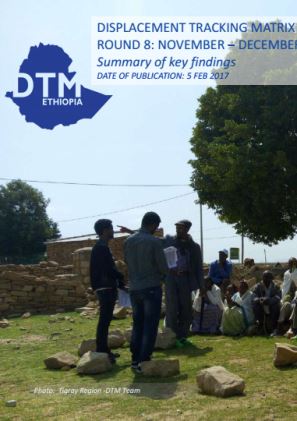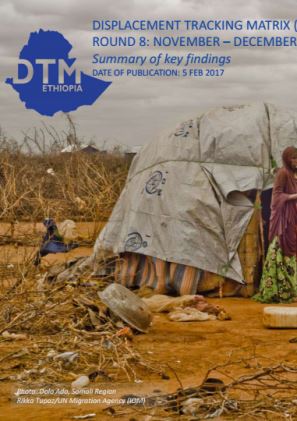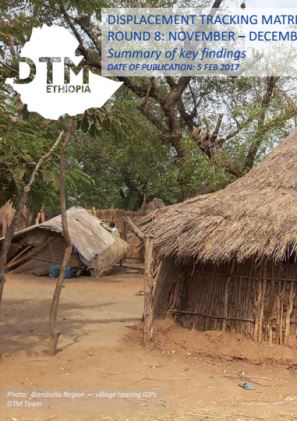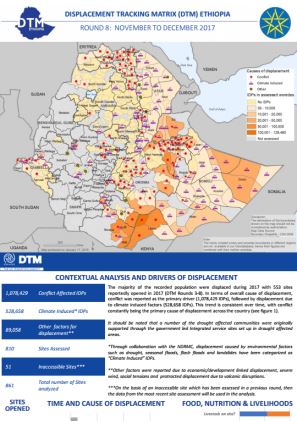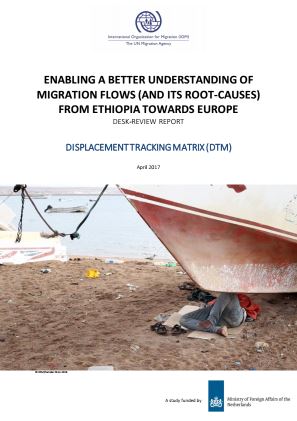-
Countries
-
Data and Analysis
-
Special Focus
-
Crisis Responses
Ethiopia
Sobre Ethiopia
Ethiopia faces one of the most complex human mobility environments in the world, with a range of social, economic, political, and climatic factors driving populations within and outside its borders. .
The Data and Research Unit (DRU) at IOM Ethiopia, through its Displacement Tracking Matrix (DTM) methodology, gathers and analyzes data to disseminate critical multi layered information on the mobility, vulnerabilities, and needs of displaced and mobile populations that enables decision makers and responders to provide these populations with better context specific assistance. Since its launch in September 2016 in Ethiopia, the DTM has grown to be a fully integrated component of Ethiopia’s national and sub-national information management architecture, as it is the official source of data on internal displacement in the country. In Ethiopia, DRU implements the following three DTM components: Mobility Tracking (MT), Flow Monitoring (FM) and Surveys.
Mobility Tracking (MT) captures internal displacement and return through three annual rounds of Site Assessment (SA) (focused on IDPs, their multisectoral needs and the availability of services in their areas of displacement) and Village Assessment Survey (VAS) (focused on host community capacity to absorb returns targeting returning IDPs and their access to services with a focus on livelihoods and reintegration). MT data is largely used to inform humanitarian response and development planning and as such is coordinated with both humanitarian and development actors in country as well as with the Ethiopia Disaster Risk Management Commission.
Flow Monitoring (FM) captures inter-and intra-regional migration flows daily at key identified transit locations. This information is largely used to inform developmental programming including migrant assistance and protection programming. Through a route-based analysis, FM data has played a pivotal role in providing evidence base to respond to the Sudan crisis coordination.
Through the regular nationwide SA and VAS tools that fall under the MT component of the DTM methodology, the DRU builds and regularly updates a master-list of locations and information about how mobile population categories are geographically spread throughout the country. The baseline information contained in the master-lists allows for the construction of sampling frameworks and the selection of statistically representative samples. Using the sampling frameworks obtained through the nationwide regular assessments, DRU is able to plan and implement household level and individual Surveys to provide representative, granular information which can be triangulated with pre-existing DTM data, as well as external data sources. This data enables the humanitarian and development communities to obtain important insight into the needs, conditions, vulnerabilities, and intentions of mobile populations which can be particularly useful in informing programs, especially with regards to durable solutions, livelihoods, and other Humanitarian, Development and Peace Nexus (HDPN) related programming and policy initiatives.
DTM Ethiopia deploys over 200 staff and enumerators to track displacement, returns and mobile populations in the country.
More information on the methodology can be found under resources.
Current Donors
- Norway
- USAID
- DG ECHO
- DG INTPA
- European Commission
- MPTF
Para obtener resultados de búsqueda más avanzados, vaya a la Página de búsqueda avanzada de informes
Ethiopia — Displacement Report 8, Tigray Region (3 November — 8 December 2017)
20,752 displaced individuals comprising 7,621 households in 61 displacement sites were identified in Tigray region. These figures represent an increase of 1,317 in the total individuals (4%), households (4.8%) and sites (3%) since round 7. Only 7 of the 61 sites opened in 2017.
Ethiopia — Displacement Report 8, Somali Region (3 November — 8 December 2017)
806,913 displaced individuals comprising 118,719 households in 331 displacement sites were identified in Somali region. These figures represent an increase of 123,692 in the total individuals (18%), households (11%) and sites (4%) since round 7. 68% sites opened in 2017.
Ethiopia — Displacement Report 8, Gambella Region (3 November — 8 December 2018)
In the Gambella Region, DTM identified 21,570 displaced individuals comprising 4,314 households in 21 displacement sites.
Ethiopia — National Displacement Dashboard 8 (November — December 2017)
The DTM data collection was conducted in collaboration with the Danish Refugee Council (DRC) between November 3rd and December 8th 2017. The majority of the recorded population were displaced in 2017, with 553 sites reportedly opened that year.
Ethiopia — Desk-Review Report: Migration Flows from Ethiopia to Europe (April 2017)
This desk review report is part of the outputs of the first phase of IOM’s project implementation on data collection to enable a better understanding of migration flows from Afghanistan, Ethiopia, Iraq, Nigeria, Pakistan and Somalia towards Europe, a collaborative effort by DTM support team and r
Pagination
- First page
- Previous page
- 1
- 2
- 3
- 4
- 5
- 6
- 7
- 8
- 9
Para obtener resultados de búsqueda más avanzados, vaya a la Página de búsqueda avanzada de conjuntos de datos


